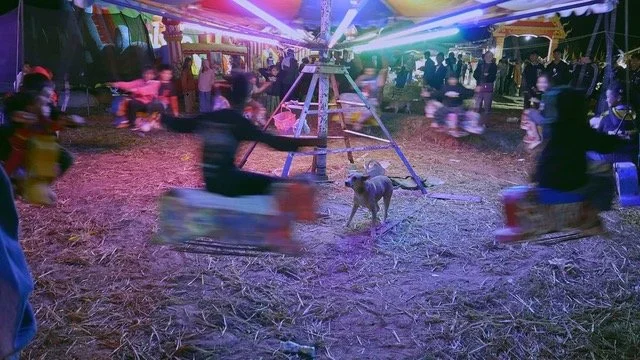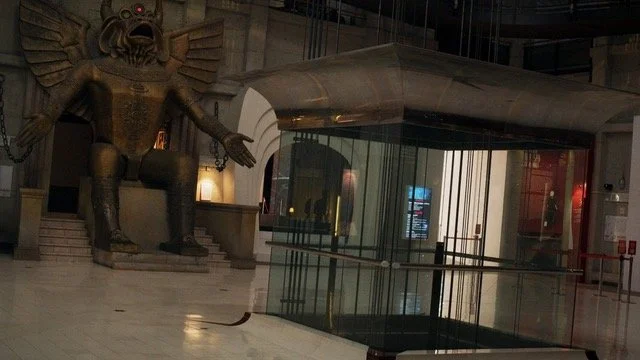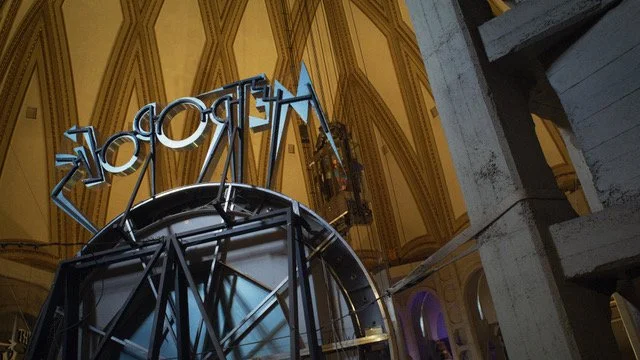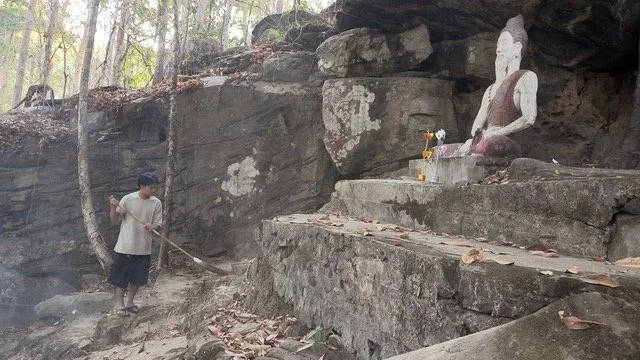Review: “Back Home”/”Ecce Mole”
A dog is trapped in the center of a whirring carnival ride, nipping and sprinting towards the edges, yet unable to break the chain of speeding children. In Tsai Ming-liang’s newest film, Back Home (2025), one of the first lengthy scenes depicts this dog amid swirling neon and grey fairground dirt, trying desperately to escape.
Tsai Ming-liang is a proponent of slow cinema, durational cinema, and observational cinema. What these words ultimately mean is this: this film has no script, barely any crew, and few visible humans. Back Home emerged from Tsai accompanying Anong Houngheuangsy (the star of his 2020 film Days) back home to Laos for three weeks. Tsai depicts Laotian landscapes, homes, animals, the Houngheuangsy family, and Anong’s travels to and from Laos with an abstract stillness and expert composition. Amid this closeness, Tsai does not speak Lao, and Houngheuangsy does not speak Mandarin.
Many describe Tsai’s technique here and elsewhere in his work as stripping cinema down to barer forms. This metaphor, and many descriptions of the film, give it an icy, conceptual edge. It is not. Tsai calls it “Handsculpted Cinema”—a better reflection of the warmth and human emphasis Tsai captures in watching and imagining the processions of homes he depicts, life in the chatter distant in the background, landscapes that are depicted as sublime because of their human footprint. There is as much emotion and context to watching men slowly paint and carve stone statues of the Buddha as watching a stream babble and flow. It is through Tsai’s still camera, the looseness and immediacy of his subject, that Tsai finds an emotional core through the act of stripping back.
The New York Film Festival programmed Back Home as a double feature with the latest installment of Heinz Emigholz’s Photography and Beyond series (1984–) titled Ecce Mole (2025), a study of two buildings in Turin designed by Alessandro Antonelli. At a run time of 28 minutes, it used triple the camera setups as Back Home and was completed in three days. It strips the documentary format of information, soundtrack, or talking head, inundating the viewer with kaleidoscopic and abstracted shots of the two Antonelli buildings: a compact home with winding staircases, and the gargantuan Mole Antonelliana with the Museo Nazionale del Cinema housed inside. We hear the interior echoes and natural sounds of these buildings and their surroundings, gaining a punctum understanding of the structures through the frenzied capture of every conceivable angle.
These buildings are opposites, and this seems to be the point. We see public and private, subtle and sublime, unified through Antonelli, Turin, and Emigholz’s static lens. The catch is that no value judgement on the buildings seems to exist beyond Emigholz’s experimentally holistic eye. He even mentions in a Q&A that he doesn’t much like the Antonelli buildings, an admission that explains the muted emotional timbre of Ecce Mole’s whirl.
There is certainly insight to be found in thirty minutes of two buildings documented over a few days. Next to Back Home, a far slower, wandering, soulful hour composed of minimal setups and organized by more concretely human thematics, Ecce Mole comes off as a quicker, yet emptier experiment. While comparing the surface similarities of these films in subject and form lets each stand more separate, it also perhaps confounds the ability of each film to stand on its own merits and experiments.
A slower, decentralized, local cinema has perhaps never felt more pressing as the globalized, technocratic world grows ever more tangled with speed, artificiality, and algorithmic subservience. I hesitated to place Back Home and Ecce Mole outside the sphere of their subjects and to artificially broaden their impact, but I was thrilled to learn that when Back Home premiered in Venice it still provoked walkouts—perhaps a clearer sign that Tsai’s “handsculpted” cinema of slow, stripped introspection is as important as ever in an art world marred by inconsequential, inhuman spectacle. These films are not broad, but their concerns are ubiquitous, and hold a unique affect today.
Back Home ends with a neatly made bed with bright white sheets and a folded towel, human, tidy, safe, devoid of the color and texture of Laos. One of the film’s first scenes began with a trapped dog, hungry and terrified, behind a speeding mechanical prison. I have seen Back Home distilled to centering themes of class divides, of what defines, binds, and segregates home, as well as less didactic concepts of exploration and live interpretation of Laos as Tsai sees it. I have seen Ecce Mole described with similarly didactic guardrails. Either way, it is the immersive and hypnotic form of these films that makes them, above all, a powerful escape.
The 63rd New York Film Festival runs from September 26 through October 13, 2025.





